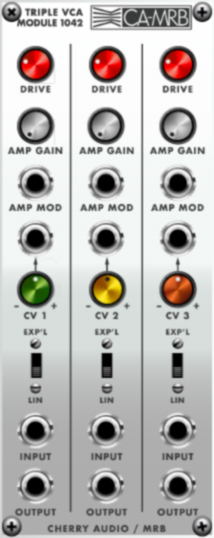
The 1042 consists of three identical voltage-controlled amplifiers. Though this module was planned, it was never produced. We felt there was a need for a dedicated multiple-VCA module, so we created it for the VM2500 series. We've included Drive knobs to give them an authentic vintage ARP sound.
The idea of a voltage-controlled amplifier (VCA) is that an audio or control signal is patched to its input, then its amplitude can be externally controlled via the CV In jack. This is useful for turning audio or control signals on or off, applying envelope volume curves to sounds, regulating the amount of modulation signals applied to audio signals, and more. Think of it as a voltage-controlled gate, with a variable amount of gate opening.
Inputs, Outputs, and Controls
Drive- Replicates the inherent mild overdrive characteristics of the original ARP VCA's. At the default setting of 32%, this is very close the original, and of course can be adjusted for more or less overdrive (or way too much). "Drive" is also a really great song by The Cars, and a horrific song by Incubus, a 90s band currently residing in the, "where are they now?" file.
Amp Gain- Adds up to 5V of gain. This works in addition to incoming Amp Mod and CV 1/2/3 jack voltages. It's also useful for manually "opening" the amplifier.
Amp Mod CV in jack- Control signal inputs are patched in here. This has no attenuator and is "wide open" all the time - typically this would be used to patch an envelope generator.
CV 1/2/3 CV in jack and attenuator- Any control signal can be patched here, including gates, LFO's, sequencers, noise generators, sample and holds, etc. Audio-rate signals can also be patched in for insane ring-mod type modulation, etc. The attenuator is bipolar, with center position = no modulation.
Exp'l/Lin- These select the "curve" of the amplifier's response as the input CV rises from 0 to 5V. Lin or linear response curve is equally proportional across the voltage input range, whereas the weirdly abbreviated Exp'l or exponential curve is closer to how the human ear perceives volume. You'll likely want to use the Lin setting for modulation or control voltage situations, and use the Exp'l setting when an envelope generator is used to control an audio signal with the amplifier. Or just use whatever sounds best, we won't tell.
Input jack- Use this jack to patch in audio or control signals to be affected by the CV In jack.
Output jack- The Output jack carries the CV-modified version of the input signal.